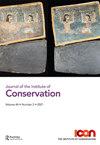Investigating the efficacy of interleaving materials in the preservation of plasticised PVC slip-cover notebooks in Yang Zhichao’s artwork Chinese Bible
IF 1
0 HUMANITIES, MULTIDISCIPLINARY
引用次数: 1
Abstract
Abstract Plasticised poly(vinyl chloride) (PVC-P) is known to degrade rapidly and emit acidic gases and, as such, it is ideally stored separately from other materials. However, due to historic or aesthetic value, PVC-P book covers in paper-based collections cannot always be removed or replaced. There is currently a gap in the literature addressing strategies for storing PVC-P associated with paper materials. Prompted by a case study of the Chinese artist Yang Zhichao’s Chinese Bible (2009)—a performance installation artwork of 3000 notebooks including approximately 1000 notebooks with PVC-P covers—three potential interleaving materials (Mylar®, Hollytex® and buffered tissue) were tested to simulate use during long-term storage. Notebooks and PVC-P book covers were purchased and assembled to model stacked storage conditions, and thermally aged at 70°C and 50% relative humidity for 130 days. Before and after ageing, samples were analysed using visual examination techniques, ATR-FTIR spectroscopy, colourimetry and weighing. It was found that all three interleaving materials lowered the probability of ink offsetting. However, cover deformation and a blotchy surface haze were more commonly observed in interleaved samples compared to non-interleaved samples. More research is necessary to identify a suitable strategy to manage PVC-P degradation in close contact storage with paper materials. This study contributes to a better understanding of the storage of plastic-covered books that may be found in libraries and archives, highlighting the complexity of conserving plastic and paper composite materials.探讨杨志超作品《中国圣经》塑化聚氯乙烯胶套笔记本中交错材料的保存效果
摘要众所周知,增塑聚氯乙烯(PVC-P)会快速降解并释放酸性气体,因此,它最好与其他材料分开储存。然而,由于历史或美学价值的原因,纸质收藏中的PVC-P书皮不能总是被移除或更换。目前,有关储存与纸张材料相关的PVC-P的策略的文献存在空白。在中国艺术家杨志超的《中国圣经》(2009)案例研究的推动下,对三种潜在的交织材料(Mylar®、Hollytex®和缓冲组织)进行了测试,以模拟长期储存期间的使用。购买笔记本和PVC-P书皮,组装成模型堆叠储存条件,并在70°C和50%相对湿度下热老化130天。在老化前后,使用目视检查技术、ATR-FTIR光谱、色度测定和称重对样品进行分析。研究发现,所有三种交织材料都降低了油墨偏移的概率。然而,与非交错样品相比,交错样品中更常见的是覆盖变形和斑点表面雾度。需要进行更多的研究,以确定一种合适的策略来管理与纸张材料密切接触储存中PVC-P的降解。这项研究有助于更好地了解图书馆和档案馆中可能存在的塑料覆盖书籍的储存情况,突出了保护塑料和纸张复合材料的复杂性。
本文章由计算机程序翻译,如有差异,请以英文原文为准。
求助全文
约1分钟内获得全文
求助全文
来源期刊

Journal of the Institute of Conservation
HUMANITIES, MULTIDISCIPLINARY-
CiteScore
1.50
自引率
0.00%
发文量
22
期刊介绍:
The Journal of the Institute of Conservation is the peer reviewed publication of the Institute of Conservation (Icon). As such, its aims reflect those of Icon, to advance knowledge and education in conservation and achieve the long term preservation and conservation of moveable and immoveable cultural heritage. The Journal provides a collective identity for conservators; it promotes and supports both the profession and professionalism. With international contributions on all aspects of conservation, it is an invaluable resource for the heritage sector. The specific aims of the Journal are to: 1. promote research, knowledge and understanding of cultural heritage conservation through its history, practice and theory 2. provide an international forum to enable and disseminate advances in research, knowledge and understanding relating to conservation and heritage 3. champion and support professional standards of heritage conservation in the UK and internationally 4. provide a permanent record of issues relating to conservation and heritage 5. be financially and operationally sustainable. To achieve these aims, the Journal invites contributions from all those involved in the conservation of cultural heritage and related activities. Areas of interest include understanding cultural heritage materials and their degradation; subject reviews and histories of cultural heritage materials and conservation treatments; new, innovative or improved approaches to conservation and collections care theory, practice, communication, management and training; case studies demonstrating new, innovative or improved approaches; and conservation in its wider context. Submitters are encouraged to demonstrate how their work is of practical application to conservation. To maintain professional standards and promote academic rigour, submissions of articles and shorter notices are subject to an anonymous peer review process.
 求助内容:
求助内容: 应助结果提醒方式:
应助结果提醒方式:


